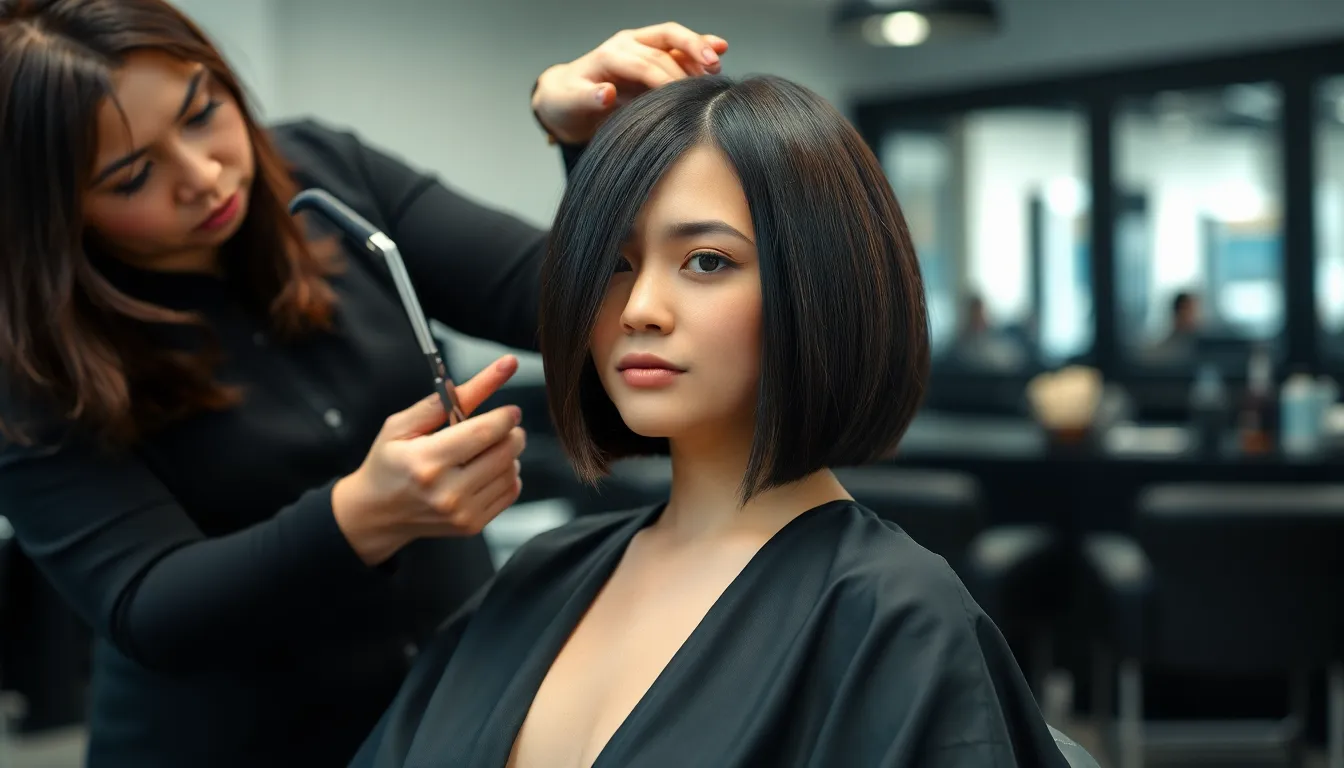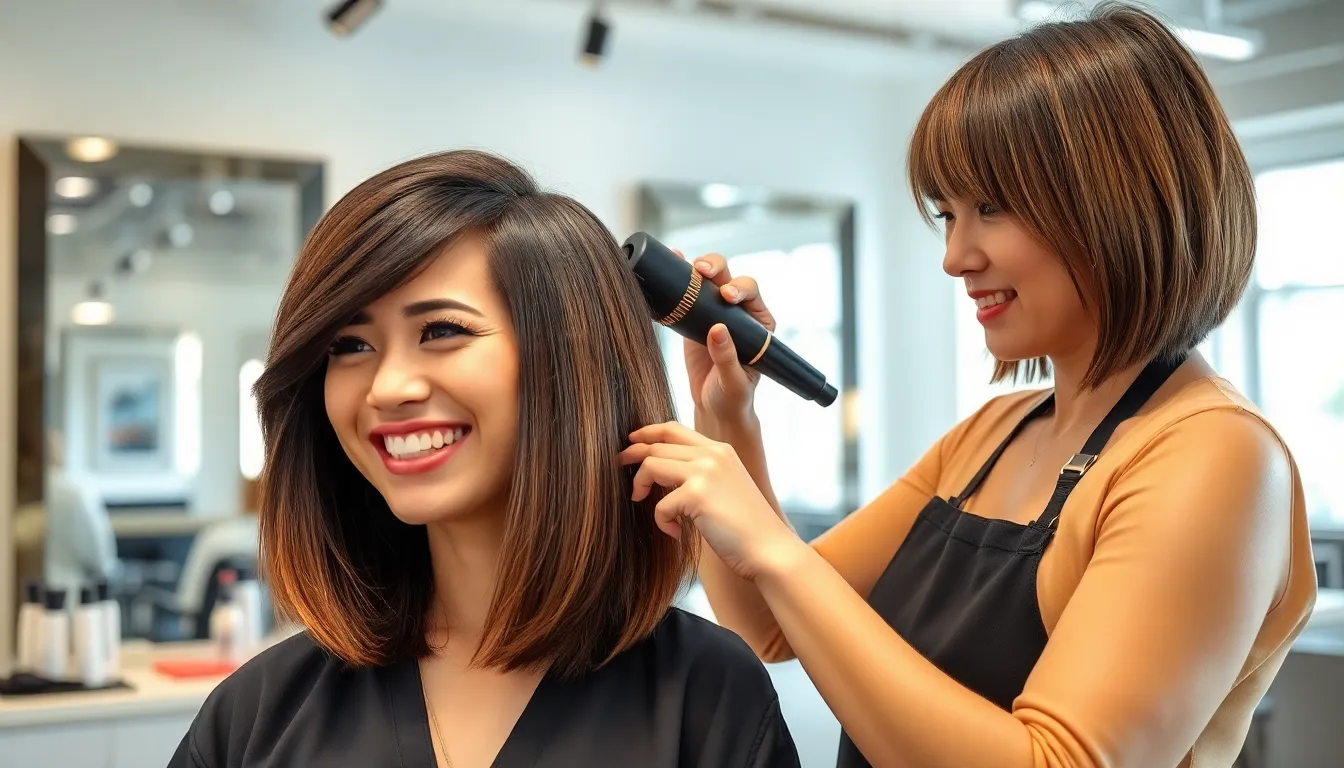We’ve all been there – staring at our thick mane in the mirror wondering how to tame it into something stylish and manageable. If you’re blessed with voluminous hair that sometimes feels more like a burden than a blessing you’re not alone. The good news? A well-crafted bob haircut might be exactly what you need to transform your thick locks into a stunning statement piece.
Bob haircuts aren’t just trendy – they’re practically revolutionary for those of us dealing with thick hair. These versatile cuts work with your hair’s natural volume rather than against it creating shapes that are both chic and surprisingly low-maintenance. From blunt bobs that embrace your hair’s fullness to layered styles that add movement and reduce bulk there’s a bob variation perfectly suited for your unique texture.
We’re about to jump into everything you need to know about choosing styling and maintaining the perfect bob for thick hair. Get ready to discover how this classic cut can become your new best friend.
Classic Blunt Bob for Thick Hair
The classic blunt bob stands as the most reliable choice for thick hair, offering structure and sophistication that naturally complements voluminous textures. This timeless cut creates clean lines that work with your hair’s natural density rather than against it.
Benefits of Sharp Lines for Volume Control
Reduces bulk effectively through precise cutting techniques that eliminate excess weight from the ends. Sharp horizontal lines create a visual boundary that prevents thick hair from appearing overwhelming or shapeless.
Creates weight distribution that naturally falls into place without requiring extensive styling. The blunt edge acts as an anchor point, allowing the middle sections to settle smoothly against your head.
Eliminates frizzy ends by removing damaged or uneven pieces that contribute to an unkempt appearance. Clean cuts seal the hair cuticle better than layered styles, resulting in smoother texture.
Provides natural movement while maintaining control over thick hair’s tendency to expand outward. The uniform length creates a swinging motion that moves as one cohesive unit.
Styling Tips for Maintaining the Shape
Use a round brush during blow drying to curve the ends slightly under for a polished finish. Start at the roots and pull the brush straight down, turning it inward only at the very ends.
Apply smoothing serum to damp hair before styling to control texture and add shine. Focus the product on the mid lengths and ends, avoiding the root area to prevent weighing down your hair.
Sleep with a silk pillowcase to reduce friction that can disrupt the blunt line overnight. Alternatively, wrap your hair in a silk scarf or use a silk bonnet to maintain the shape.
Schedule regular trims every 6 to 8 weeks to keep the blunt edge sharp and prevent split ends. Even small amounts of growth can compromise the clean line that makes this cut so effective.
Blow dry with cool air for the final minute of styling to set the shape and add lasting shine. Hot air opens the hair cuticle while cool air seals it closed, locking in your style.
Best Length Options for Different Face Shapes
| Face Shape | Ideal Length | Key Benefits |
|---|---|---|
| Round | Chin length or longer | Elongates face, avoids adding width at cheeks |
| Square | Just below jawline | Softens angular features, creates gentle curves |
| Heart | Collarbone length | Balances wider forehead with fuller bottom section |
| Oval | Any length works | Versatile shape accommodates all bob variations |
| Long | Shoulder grazing | Adds horizontal width to balance vertical proportions |
Round faces benefit most from bobs that hit at the collarbone or slightly longer to create vertical lines. Avoid cutting at the widest part of your face, typically around the cheek area.
Square faces look stunning with bobs that end just below the jawline, softening sharp angles naturally. The blunt edge creates gentle curves that complement strong bone structure beautifully.
Heart shaped faces need length at the collarbone to balance a wider forehead with the fuller bottom section of the bob. This proportion creates harmony between your upper and lower facial features.
Long faces require width at shoulder level to break up vertical lines and create the illusion of broader proportions. The horizontal blunt edge adds necessary visual weight to balance your features.
Layered Bob for Thick Hair Management

Layered bob cuts offer the perfect solution for taming thick hair’s natural volume while maintaining style versatility. Strategic layering transforms heavy, dense hair into a manageable and ever-changing hairstyle.
How Layers Reduce Bulk and Weight
Internal layering removes excess weight from thick hair without sacrificing length or shape. We recommend starting layers about two inches from the crown to preserve the bob’s structure while eliminating heaviness at the bottom.
Long layers create natural movement by allowing hair to fall in cascading sections rather than one heavy block. Professional stylists typically cut these layers at 45-degree angles to maintain the bob’s perimeter while reducing bulk throughout the interior.
Graduated layering techniques work particularly well for thick hair because they remove weight strategically from problem areas. We suggest focusing layer placement around the ears and nape where thick hair tends to accumulate the most bulk.
Point cutting methods help blend layers seamlessly while removing additional weight from thick strands. This technique creates softer edges that move naturally with your hair’s texture rather than fighting against it.
Texturizing Techniques for Better Movement
Razor cutting creates effortless texture in thick hair by slicing through strands at varying angles. We prefer this method for clients who want their layered bob to have more fluid movement and less rigid structure.
Thinning shears remove density without creating obvious layering lines in thick hair. Professional colorists often use these scissors to blend layers and create seamless transitions between different lengths.
Channel cutting adds movement by creating small sections of varying lengths throughout the hair. We recommend this technique for extremely thick hair that needs maximum bulk reduction while maintaining the bob’s overall shape.
Slide cutting produces natural texture by running scissors along the hair shaft to remove weight and create movement. This method works exceptionally well for thick hair that tends to look triangular or pyramid-shaped when cut with traditional methods.
Maintenance Requirements for Layered Styles
Regular trims every 6-8 weeks keep layered bobs looking fresh and prevent thick hair from overwhelming the cut’s shape. We schedule more frequent appointments for clients with fast-growing thick hair to maintain the style’s integrity.
Professional touch-ups become essential for maintaining layer placement and texture in thick hair. Stylists typically need to reshape layers every other appointment to prevent the cut from becoming too heavy or losing its movement.
At-home styling adjustments help thick hair maintain its layered bob shape between salon visits. We recommend using texturizing products daily and learning proper blow-drying techniques to enhance the layers’ natural movement.
Product rotation prevents buildup that can weigh down layered thick hair and diminish the cut’s effectiveness. We suggest alternating between lightweight mousses, texturizing sprays, and volumizing products to keep layers looking fresh and bouncy.
A-Line Bob for Thick Hair Structure

The A-line bob transforms thick hair’s natural density into a structured style that maintains elegance while managing volume effectively. This graduated cut creates a sophisticated silhouette that works with your hair’s natural texture.
Creating Sleek Lines with Thick Textures
Precision cutting techniques form the foundation of a successful A-line bob for thick hair. We recommend starting with wet hair sectioning to ensure even weight distribution throughout the cut. Point cutting along the perimeter softens harsh edges while maintaining the bob’s distinctive angle.
Strategic thinning removes excess bulk without compromising the style’s integrity. Texturizing shears work best when used sparingly on the interior sections, focusing on areas where thickness creates unwanted volume. Professional stylists typically thin approximately 20-30% of the hair’s bulk to achieve optimal results.
Graduation angles between 15-45 degrees create the most flattering A-line shape for thick hair types. Steeper angles work better for extremely dense hair, while gentler graduations suit moderately thick textures. This angle variation prevents the bottom section from appearing too heavy or overwhelming.
Angle Variations for Different Hair Densities
Subtle graduation suits fine thick hair that lacks coarseness but has abundant strands. We suggest a 15-20 degree angle that creates gentle movement without removing too much length from the back sections. This approach maintains fullness while providing structure.
Moderate angles work perfectly for medium density thick hair with average strand thickness. A 25-35 degree graduation offers the ideal balance between volume control and style maintenance. This range provides enough angle to prevent bottom heaviness while preserving the bob’s classic proportions.
Dramatic graduation becomes necessary for extremely thick, coarse hair textures. Angles reaching 40-45 degrees help manage overwhelming volume and create the distinctive A-line silhouette. Steeper cuts require more frequent maintenance but deliver superior shape retention for challenging hair types.
Custom adjustments allow stylists to modify standard angles based on individual hair characteristics. Cowlicks, growth patterns, and density variations may require angle modifications throughout different sections of the cut.
Styling Products That Enhance the Shape
Heat protectant serums provide essential protection while smoothing thick hair cuticles during styling. We recommend applying these products to damp hair before blow drying to prevent damage and reduce frizz. Silicone based formulas work particularly well for creating sleek A-line shapes.
Volumizing mousses help distribute thick hair’s natural volume more evenly throughout the bob structure. Apply these lightweight formulas to roots and mid lengths, avoiding the ends to prevent weighing down the graduated sections. This technique enhances the A-line’s natural lift and movement.
Smoothing creams control flyaways and enhance the bob’s clean lines without adding unwanted weight. Choose alcohol free formulas that provide moisture while maintaining the cut’s precision. Apply sparingly to ends and problem areas where thick hair tends to become unruly.
Texturizing sprays add definition to the A-line’s graduated layers while maintaining natural movement. These products work best on dry hair as a finishing touch to enhance the cut’s structure. Light application prevents buildup that can flatten thick hair’s natural body.
Inverted Bob for Thick Hair Volume

We’ve found that inverted bobs offer the perfect balance between height and weight management for thick hair textures. This ever-changing style transforms heavy hair into a voluminous masterpiece that enhances natural texture while maintaining control.
Adding Height While Managing Weight
Creating lift at the crown requires strategic cutting techniques that redistribute thick hair’s natural weight. We recommend starting with longer lengths at the back nape area and gradually increasing volume toward the crown section. Professional stylists use elevation angles between 45 to 90 degrees when cutting the interior layers to achieve maximum height without compromising the overall silhouette.
Internal layering techniques work best when applied to the middle sections of thick hair strands. Texturizing shears remove approximately 30% of bulk from problem areas while maintaining the bob’s structural integrity. Point cutting along the perimeter creates natural movement that prevents the inverted shape from appearing too heavy or blocky.
Weight distribution becomes crucial when working with dense hair textures that tend to pull downward. We position the shortest point of the inversion just above the occipital bone to create natural lift and prevent the style from falling flat. This placement technique ensures that thick hair maintains its intended shape throughout the day without requiring excessive product application.
Stacking Techniques for Thick Hair Types
Graduated stacking begins at the nape with precision cutting that creates defined layers without removing too much length. We use horizontal sectioning patterns that follow the natural growth patterns of thick hair to ensure seamless blending between stacked sections. Each layer should be approximately 1/4 inch shorter than the section below it to maintain proper graduation.
Razor cutting techniques enhance the stacked effect by creating soft edges that blend naturally with thick hair’s texture. Professional colorists often recommend this method for clients with coarse or resistant hair types that don’t respond well to traditional scissor cuts. Thinning shears applied at 45-degree angles help reduce bulk in the stacked areas while maintaining the bob’s overall density.
Customizing stack height depends on individual hair density and face shape considerations. We typically recommend higher stacks for clients with extremely thick hair who want maximum volume reduction in the back sections. Lower stacking works better for those who want subtle texture enhancement without dramatic shape changes.
Tools Needed for At-Home Styling
Essential brushes include a paddle brush for initial detangling and a round barrel brush sized between 1.5 to 2 inches for creating volume at the roots. We recommend natural bristle brushes that won’t snag thick hair strands during the styling process. A fine-tooth comb helps separate sections cleanly when applying products or creating precise parts.
Heat styling tools require exact wattage levels to effectively manage thick hair textures. We suggest blow dryers with at least 1800 watts of power and ionic technology that reduces frizz while cutting drying time. Flat irons should reach temperatures between 350 to 400 degrees Fahrenheit to smooth thick strands without causing damage.
| Tool Category | Recommended Specifications | Purpose |
|---|---|---|
| Blow Dryer | 1800+ watts, ionic technology | Volume creation and frizz control |
| Round Brush | 1.5-2 inch barrel, natural bristles | Root lifting and shape enhancement |
| Flat Iron | 350-400°F, ceramic plates | Smoothing and edge refinement |
| Styling Clips | Metal construction, strong grip | Section separation during styling |
Product essentials include heat protectant sprays applied before any thermal styling and volumizing mousses that enhance the inverted bob’s natural lift. We recommend lightweight serums for the mid-lengths and ends that won’t weigh down the stacked sections. Texturizing sprays add grip and definition to thick hair that tends to be too slippery for traditional styling products.
Chin-Length Bob for Thick Hair Balance

Chin length bobs create perfect equilibrium for thick hair by providing enough weight to prevent excessive volume while maintaining sophisticated style. This versatile length offers manageable daily styling while improving natural facial features.
Proportional Considerations for Full Hair
Thick hair requires exact proportional guidelines to achieve balanced chin length cuts that enhance rather than overwhelm your features. Hair density distribution becomes crucial at this length since excessive bulk around the jawline can create unflattering weight lines that add visual heaviness to your face.
We recommend maintaining 2 to 3 inches of length below your chin to create optimal weight balance while preventing the mushroom effect common with shorter thick hair cuts. Professional stylists typically reduce internal bulk by 30 to 40 percent through strategic layering techniques that preserve the bob’s essential structure.
Sectioning ratios play a vital role in achieving proportional balance, with most successful chin length bobs following a 60/40 weight distribution pattern. The lower 60 percent carries the primary bulk while the upper 40 percent provides movement and prevents top heavy appearance that thick hair naturally creates.
Face width considerations determine the exact positioning of your chin length bob, with wider faces benefiting from lengths that extend 1 to 2 inches past the jawline. Narrower face shapes can accommodate shorter variations that hit directly at chin level without creating disproportionate bulk.
Face Framing Benefits of This Length
Chin length bobs excel at creating natural face framing effects that highlight your best features while minimizing areas you prefer to downplay. Forward angled cutting techniques ensure that hair naturally falls toward your face, creating soft framing that enhances cheekbone definition and jawline structure.
Strategic layering around the perimeter creates customizable face framing that adapts to your unique facial geometry. Subtle graduation techniques allow thicker sections near your temples while maintaining lighter weight around your chin and neck area.
Asymmetrical variations work exceptionally well with thick hair at chin length, creating ever-changing movement that prevents the static look common with blunt cuts. These variations typically feature 1 to 2 inch length differences between sides, providing visual interest while maintaining professional appearance.
Styling versatility becomes a major advantage since chin length thick hair can be tucked behind ears to reveal facial features or worn forward for more coverage. Heat styling techniques like slight inward curls enhance the face framing benefits by directing hair toward your facial contours.
Color placement strategies complement face framing benefits through strategic highlighting that creates depth around your face. Dimensional coloring techniques work particularly well with chin length thick hair, adding movement and preventing flat appearance.
Everyday Styling Methods for Busy Lifestyles
Busy schedules demand efficient styling methods that work with thick hair’s natural tendencies rather than fighting against them. Quick blow dry techniques using medium barrel brushes can create polished chin length styles in 8 to 12 minutes with proper sectioning methods.
Air drying approaches work exceptionally well for thick chin length bobs when you apply lightweight mousse while hair remains damp. Scrunching motions enhance natural texture while preventing frizz formation that commonly affects thick hair types.
Overnight styling methods maximize morning efficiency through strategic preparation techniques. Silk scarf wrapping or braiding slightly damp hair creates gentle waves that require minimal morning touch ups for polished appearance.
Heat free styling options include twist and pin methods that create volume and movement without daily heat damage. These techniques work particularly well during humid weather when thick hair tends to expand beyond desired boundaries.
Product rotation prevents buildup while maintaining styling effectiveness throughout busy weeks. Dry shampoo applications extend clean hair periods by 2 to 3 days while adding texture that makes thick hair more manageable for quick styling sessions.
Essential styling tools for busy lifestyles include dual voltage travel dryers, compact round brushes, and multi use styling creams that provide heat protection and hold. These streamlined tool selections enable consistent results whether you’re styling at home or traveling for work.
Long Bob (Lob) for Thick Hair Versatility

Long bobs offer the perfect compromise for thick hair, providing enough length to weigh down volume while delivering maximum styling flexibility. We’ve found that lobs work exceptionally well for those transitioning from longer styles who aren’t ready for dramatic change.
Maintaining Weight While Adding Style Options
Maintaining strategic weight distribution is crucial when crafting a lob for thick hair. We recommend keeping length between the collarbone and mid-chest area to prevent the pyramid effect that shorter cuts can create with dense hair textures.
Weight placement techniques focus on preserving density at the perimeter while removing bulk through internal layering. Our stylists typically thin hair starting 2-3 inches from the ends, which maintains the lob’s signature blunt appearance while reducing heaviness.
Strategic cutting angles help distribute weight evenly throughout the style. We suggest using a slight forward angle of 5-10 degrees to create subtle movement without compromising the structural integrity that thick hair requires.
Internal texturizing removes excess bulk while preserving the lob’s sleek silhouette. Thinning shears work best when used sparingly on the mid-lengths, creating breathing room for thick strands without visible choppy layers.
Styling Variations from Straight to Wavy
Straight styling showcases the lob’s clean lines while taming thick hair’s natural volume. We achieve this look using a paddle brush during blow drying, followed by a flat iron on 300-350°F to smooth the hair shaft without causing damage.
Beachy waves transform the structured lob into a relaxed, effortless style perfect for thick hair textures. We create these waves using a 1.5-inch curling iron, wrapping sections away from the face and leaving ends out for modern appeal.
Textured waves add dimension and movement to thick lobs through scrunching techniques with sea salt spray. This method works particularly well on air-dried hair, improving natural texture while reducing styling time.
Sleek styling requires lightweight serums and ionic blow dryers to combat thick hair’s tendency toward frizz. We recommend applying smoothing products to damp hair before blow drying with a round brush for professional results.
Transitioning from Longer Hair Lengths
Gradual trimming eases the transition from long to lob length over several appointments. We typically remove 2-3 inches per session, allowing clients to adjust to shorter lengths while maintaining hair health.
Shape adjustment focuses on creating the lob’s signature structure from existing long layers. Our approach involves establishing the perimeter first, then working upward to blend any existing layers into the new shape.
Maintenance scheduling becomes more frequent when transitioning to a lob, requiring trims every 6-8 weeks instead of the 10-12 weeks typical for longer styles. This schedule maintains the lob’s crisp lines while managing thick hair’s growth patterns.
Styling adaptation requires learning new techniques suited to shorter lengths. We teach clients to adjust their product amounts and tool selections, as lobs typically need less product but more precise styling methods than longer hair.
Textured Bob for Thick Hair Movement

Textured bobs transform thick hair’s natural volume into effortless, stylish movement. We’ll explore cutting techniques and styling methods that enhance your hair’s inherent texture while maintaining a polished bob silhouette.
Creating Natural-Looking Waves and Texture
Air drying creates the most authentic wave patterns in thick textured bobs. We recommend applying a lightweight leave-in conditioner while hair is 70% dry, then scrunching gently with your hands to encourage natural curl formation.
Scrunching techniques work exceptionally well with thick hair’s density. Start at the ends and work upward, using a cotton t-shirt or microfiber towel to reduce frizz while improving definition.
Diffusing offers controlled drying for enhanced texture. Use low heat and medium airflow, cupping sections of hair in the diffuser bowl for 30-second intervals to create volume without disrupting natural wave patterns.
Braiding methods provide heat-free texture overnight. Create 2-3 loose braids on damp hair, focusing the braids from mid-length to ends to maintain the bob’s structure while adding movement.
Twist outs generate spiral textures that complement thick bob cuts. Section damp hair into 6-8 pieces, twist each section tightly, then unravel when completely dry for defined, bouncy waves.
Cutting Techniques That Add Flow
Point cutting creates soft, feathered edges that move naturally with thick hair’s weight. We use this technique along the perimeter to eliminate harsh lines while maintaining the bob’s overall shape.
Razor cutting adds instant movement by creating varying lengths within each hair strand. This method works particularly well on thick hair because it reduces bulk while encouraging natural texture to emerge.
Thinning shears strategically remove density from problem areas without compromising length. Focus on mid-shaft thinning rather than end thinning to maintain the bob’s weight distribution.
Internal texturizing creates hidden layers that reduce bulk while adding flow. We cut these invisible layers throughout the interior, allowing thick hair to move more freely without losing the bob’s silhouette.
Disconnected layers provide dramatic movement by creating intentional length variations. These layers start 2-3 inches from the ends and blend seamlessly into the bob’s overall structure.
Products That Enhance Natural Texture
| Product Type | Application Method | Hair Benefit | Best For |
|---|---|---|---|
| Sea Salt Spray | Damp hair, scrunch | Enhances waves | Wavy thick hair |
| Texturizing Cream | Mid-lengths to ends | Defines curls | Curly thick hair |
| Volume Mousse | Roots when damp | Lifts without weight | Fine thick hair |
| Curl Cream | Throughout damp hair | Reduces frizz | Coarse thick hair |
Lightweight oils like argan or jojoba smooth thick hair without weighing down texture. Apply 2-3 drops to damp ends, avoiding the root area to maintain volume and movement.
Texture sprays add grip and definition to thick bob cuts. Spray on dry hair and scrunch for enhanced waves, or apply to damp hair before air drying for subtle texture.
Sea salt formulas mimic beach waves while adding volume to thick hair. These products work best when applied to towel-dried hair, then scrunched and air dried for natural-looking movement.
Curl improving gels define texture without crunchiness when used sparingly. Apply a quarter-sized amount to very damp hair, distributing evenly before scrunching and diffusing.
Root lifting sprays create volume at the crown while maintaining textured ends. Spray directly onto damp roots, then lift sections while blow drying with a diffuser attachment.
Asymmetrical Bob for Thick Hair Edge

Asymmetrical bobs create striking visual interest while strategically managing thick hair’s natural volume through carefully planned uneven lengths. This edgy variation transforms your hair’s density into a fashion-forward statement piece.
Balancing Uneven Lengths with Full Hair
Creating balance with asymmetrical cuts requires strategic weight distribution across your thick hair’s natural volume. Professional stylists recommend starting with a 2-3 inch length difference between the shortest and longest sections to maintain proportion without overwhelming your facial features.
Internal layering becomes crucial for preventing the longer side from appearing too heavy or triangular. We suggest requesting razor texturizing through the mid-lengths to reduce bulk while maintaining the asymmetrical line’s dramatic effect. This technique ensures your thick hair doesn’t create an unbalanced silhouette.
Face framing angles should complement your asymmetrical design by directing attention to your best features. Shorter sections work exceptionally well when positioned to highlight cheekbones or jawlines, while longer portions can soften angular facial structures.
Strategic thinning along the nape and behind the ears prevents your thick hair from creating unwanted bulk in shorter sections. Professional thinning shears used at 30-degree angles help blend the asymmetrical transition seamlessly.
Modern Styling Approaches for Bold Looks
Embracing your asymmetrical bob’s edgy potential means experimenting with contemporary styling techniques that enhance the uneven lengths. Sleek straightening on the longer side creates maximum contrast with textured shorter sections, amplifying the cut’s dramatic effect.
Finger styling works particularly well for thick hair in asymmetrical cuts, allowing you to enhance natural movement while controlling volume. We recommend applying lightweight texturizing cream to damp hair before scrunching the shorter sections for added definition.
Strategic curling can transform your asymmetrical bob into various looks throughout the week. Curl only the longer sections using a 1.5-inch barrel for romantic waves, or add texture to shorter pieces with a smaller curling iron for punk-inspired volume.
Color placement enhances asymmetrical cuts by highlighting the length difference through strategic highlights or lowlights. Darker tones on shorter sections create depth, while lighter accents on longer pieces draw attention to the asymmetrical design.
Maintenance Tips for Asymmetrical Cuts
Maintaining your asymmetrical bob’s sharp lines requires more frequent salon visits compared to symmetrical styles. We recommend scheduling appointments every 4-5 weeks to preserve the cut’s intentional uneven lengths and prevent your thick hair from losing its structured shape.
Home trimming should be avoided entirely with asymmetrical cuts, as even minor adjustments can disrupt the carefully calculated balance. Professional stylists understand how your thick hair grows and can maintain proper proportions during each trim.
Product rotation becomes essential for managing different lengths within one hairstyle. Use volumizing mousse on shorter sections that need lift, while applying smoothing cream to longer pieces that require weight and control.
Sleeping protection helps maintain your asymmetrical shape overnight through silk pillowcases and strategic positioning. We suggest loosely pinning longer sections up to prevent flattening, while allowing shorter pieces to maintain their natural texture and volume.
Daily styling should focus on improving rather than fighting your cut’s intentional asymmetry. Quick touch ups with texturizing spray on shorter sections and smoothing serum on longer pieces keep your look polished throughout the day.
Professional Styling Tips for Thick Hair Bobs

Mastering the art of styling thick hair bobs requires exact techniques that work with your hair’s natural density rather than against it. These professional strategies will help you achieve salon-quality results while maintaining your bob’s structure and movement.
Heat Protection and Tool Selection
Temperature control becomes crucial when styling thick hair bobs because excessive heat can damage dense strands and create unwanted frizz. We recommend using adjustable temperature tools that allow you to customize heat settings based on your hair’s exact needs and thickness level.
Ceramic or tourmaline tools work best for thick hair because they distribute heat evenly and reduce hot spots that can cause damage. Ionic blow dryers help break down water molecules faster, cutting your drying time in half while sealing the hair cuticle for smoother results.
Heat protectant application requires strategic layering when working with thick hair bobs. Apply a thermal protectant spray to damp hair in sections, ensuring every strand receives coverage before using any heated styling tools. We suggest reapplying heat protectant when switching between different tools during your styling routine.
Round brush sizing makes a important difference in achieving professional results with thick hair bobs. Use larger barrel brushes (2-3 inches) for the main sections to create volume and smoothness, while smaller brushes (1-1.5 inches) work perfectly for face-framing pieces and detail work around the neckline.
Daily Maintenance Routines That Work
Morning preparation starts with proper overnight protection to maintain your bob’s shape and reduce styling time. Sleep on silk or satin pillowcases to minimize friction, and consider loosely braiding or pinning sections if your bob tends to flatten overnight.
Product rotation prevents buildup that can weigh down thick hair bobs and diminish their movement. Alternate between volumizing shampoos, clarifying treatments, and moisturizing formulas throughout the week to keep your hair balanced and responsive to styling.
Section styling ensures even results when working with thick hair density. Divide your bob into 4-6 horizontal sections during blow drying, starting from the bottom and working upward to achieve consistent smoothness and volume distribution.
Touch up techniques save time during busy mornings while maintaining your bob’s polished appearance. Use a small amount of smoothing serum on dry hair to tame flyaways, or apply texturizing spray to add movement and refresh yesterday’s style.
Weekly deep conditioning treatments help manage thick hair’s tendency toward dryness and maintain your bob’s healthy appearance. Focus the treatment on mid lengths and ends, avoiding the roots to prevent weighing down your style.
Common Mistakes to Avoid When Styling
Over brushing thick hair bobs creates unnecessary volume and can disrupt the cut’s intended shape and movement. Brush only when necessary, and use wide tooth combs on wet hair to prevent breakage and maintain your bob’s structure.
Using too much product weighs down thick hair and can make your bob appear greasy or flat. Start with small amounts and build coverage gradually, focusing on mid lengths and ends rather than applying product near the roots.
Skipping sectioning leads to uneven styling that becomes more noticeable with thick hair’s density. Always divide your hair into manageable sections during styling to ensure consistent heat distribution and smooth results throughout your bob.
Styling against your hair’s natural growth pattern creates resistance and can make your bob appear awkward or forced. Work with your hair’s natural direction and cowlicks to achieve a more polished and effortless looking result.
Neglecting regular maintenance appointments allows thick hair bobs to lose their shape more quickly than other cuts. Schedule trims every 6-8 weeks to maintain your bob’s precise lines and prevent the weight from accumulating in problem areas.
Conclusion
We’ve explored how the right bob can transform thick hair from a daily struggle into your greatest styling asset. Each variation we’ve discussed offers unique benefits that work with your hair’s natural volume rather than against it.
The key lies in choosing a bob that complements your face shape and lifestyle while incorporating the proper cutting techniques. Whether you prefer the clean lines of a blunt bob or the movement of textured styles professional execution makes all the difference.
Remember that maintaining your bob requires the right tools products and techniques. Regular trims proper heat protection and strategic styling will keep your thick hair looking polished and manageable every day.
Frequently Asked Questions
What makes a blunt bob ideal for thick hair?
A blunt bob offers structure and sophistication that complements thick hair’s natural volume. The sharp, even lines effectively reduce bulk through strategic weight distribution, eliminate frizzy ends, and create natural movement. This classic cut provides a low-maintenance style while working with your hair’s natural texture rather than fighting against it.
How should I style my thick hair bob for best results?
Use a round brush during blow-drying to smooth the hair shaft and create movement. Apply a smoothing serum before heat styling to reduce frizz and add shine. Sleep on silk pillowcases to prevent friction and maintain your style overnight. Regular trims every 6-8 weeks help maintain the bob’s shape and prevent split ends.
Which bob length works best for my face shape?
For round faces, choose chin-length or longer bobs to elongate your features. Square faces benefit from cuts just below the jawline to soften angles. Heart-shaped faces look great with collarbone-length bobs that balance wider foreheads. Long faces are flattered by shoulder-grazing styles that add width and create proportion.
How do layered bobs help manage thick hair volume?
Layered bobs use internal layering to reduce bulk without sacrificing overall length. The graduated layering technique focuses on problem areas where hair tends to be heaviest. This approach maintains the bob’s structure while creating movement and preventing the triangular shape that thick hair often develops in blunt cuts.
What’s the difference between an A-line and inverted bob?
An A-line bob gradually increases in length from back to front, creating a sleek, structured look that manages volume while maintaining elegance. An inverted bob features shorter layers at the back with longer pieces in front, creating height at the crown while redistributing weight for better balance and movement.
How often should I trim my thick hair bob?
Thick hair bobs require regular maintenance every 6-8 weeks to maintain their shape and prevent bulk buildup. Professional touch-ups help keep layers balanced and edges sharp. Between appointments, minor at-home styling adjustments can help manage growth, but avoid cutting the hair yourself to maintain the bob’s precision.
What products work best for styling thick hair bobs?
Essential products include heat protectants to prevent damage, volumizing mousses for lift without weight, smoothing creams to control frizz, and texturizing sprays for movement. Rotate products regularly to prevent buildup, and choose lightweight formulas that won’t weigh down your hair or create excess oil.
Can I achieve a textured bob with thick hair?
Yes, textured bobs work excellently with thick hair by transforming natural volume into effortless movement. Point cutting and razor cutting techniques enhance texture while maintaining a polished look. Air drying with scrunching, using sea salt sprays, and diffusing can create natural waves without heat damage.







